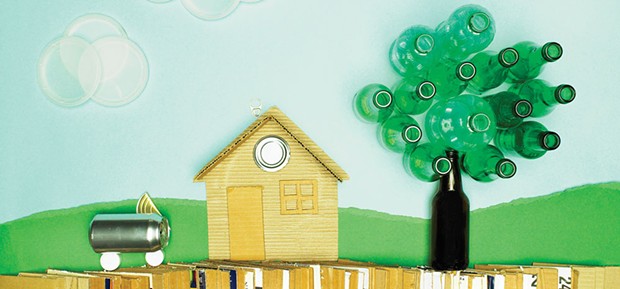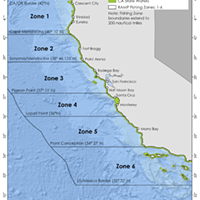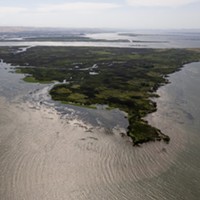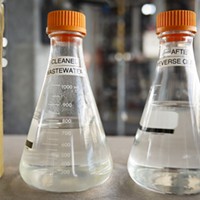How Green is Humboldt?
Humboldt has a decidedly eco-groovy reputation, but is it deserved?
[
{
"name": "Top Stories Video Pair",
"insertPoint": "7",
"component": "17087298",
"parentWrapperClass": "fdn-ads-inline-content-block",
"requiredCountToDisplay": "1"
}
]
As the world readies to celebrate Earth Day on April 22, it seems a fitting time to take a good, hard look in the mirror.
Yes, Humboldt County, home to towering redwood trees, flowing rivers and a magnificent coastline, was green before it was cool. It's a place where folks outfitted their homes with solar panels before they were cost-effective and where farmers markets were commonplace before kale was hip. Humboldt County certainly has green credentials, but are they deserved? Is Humboldt living up?
The Journal looked at six major indicators: electricity consumption, government policies, waste diversion, transportation and water and air quality. The results are mixed, and maybe a bit surprising. Here's what we found.
Trashy
In 2011, Humboldt County residents sent 158 million pounds of garbage to landfills near Redding and Medford, Ore. But by state standards, we're doing pretty well. We diverted more than twice that amount, keeping it out of the landfills, through recycling, compost and other means.
Karen Sherman, Humboldt Waste Management Authority's senior programs analyst, says the authority's member agencies are keeping far more trash out of the dump than the state mandates. HWMA's collective jurisdictions (Eureka, Arcata, Blue Lake, Ferndale, Rio Dell and unincorporated Humboldt) diverted 69 percent of their garbage in 2011, well above the state goal of 50 percent, but still below an upcoming 2020 mandate of 75 percent diversion.
CalRecycle Assistant Director of Public Affairs Mark Oldfield says "diversion" is kind of an old metric when it comes to reducing garbage. Nowadays, the state assigns a pounds-per-person-per-day number to every jurisdiction in the state and monitors how closely it meets that goal.
In 2011, Ferndale was the only Humboldt jurisdiction to exceed its target, pumping out 4.1 pounds per day per person of trash to its 3.4 pounds per person per day goal. The state gave the city a pass, citing a good faith effort.
"As a whole, the county is doing very well," Oldfield says. It's tough to compare jurisdictions, he continues, because places with more industry are going to put out far more waste. That's why each city and county is given an independently calculated goal. In 2012, the state produced 4.4 pounds of garbage per person per day — a staggering 61 billion pounds of crap.
Meanwhile, the HWMA released a strategic plan to reach its 75 percent diversion goal, which will require reducing garbage by another 14,000 tons annually. And good progress is being made, with bundled recycling and garbage in McKinleyville making it easier for folks to recycle, new green waste programs, bulky item pickup in some jurisdictions and a planned mandatory curbside pickup for Eureka businesses.
The authority is using a lot of gas to haul its garbage to landfills near Redding and Medford — and contracts with those dumps are up for renewal soon.
Particularly laudable, Sherman says, is the HWMA's hazardous waste program, which sends trucks out to rural areas regularly. "Jurisdictions and counties that are much larger in population size seem to be surprised and pleased at what we can do here with a smaller base of people and funding."
Talking Trash
Total trash disposed by HWMA in 2011: 79,082 tons or 158 million pounds of garbage.
Total tons diverted: 178,039
Current combined member agency diversion rate: 69 percent
Additional tons needed to reach 75 percent diversion goal: 14,000
Garbage is hauled to Anderson Landfill outside of Redding (162 miles) or to Dry Creek Landfill near Medford (197 miles).
Garbage generated per day per person, in pounds
Arcata: Target 3.7, actual 2.5
Blue Lake: Target 19.1 -2.5
Eureka: Target 6.5, actual 5.7
Ferndale: Target 3.4, actual 4.1
Fortuna: Target 4.3, actual 3.8
Unincorporated Humboldt: Target 3.6, actual 2.8
Rio Dell: Target 3.2, actual 2.1
Trinidad: Target 8.2, actual 8.0
Statewide average (there is no statewide target): 4.4Targets for different jurisdictions vary, particularly in towns with little population and where industrial businesses may increase waste production.
Source: CalRecycle
— Grant Scott-Goforth
Green government
Combining to employ nearly 10,000 people and bestowed with the power of regulation, Humboldt County's local governments have a lot to do with our environmental footprint. The good news is that most have green policies in place, ensuring environmental impact is considered in all major decisions, whether it be approving a construction project or buying new paper for the copier.
When it comes to green policies, Arcata has set the pace. The city's deputy director of Environmental Services, Karen Diemer, says that the city has green purchasing policies that put a premium on recycled products (the city tried to purchase 100 percent recycled paper but had a difficult time running it through its copiers), a green fleet policy that prioritizes fuel efficiency and mandatory curbside recycling services. There's also a prohibition on the purchase of tropical hardwoods for city facilities, and a plan that bans the use of pesticides and herbicides on city properties, except in the most extreme of cases.
But, Diemer says, the city's green commitment extends all the way to the city council's putting a priority on alternative transportation, environmentally-friendly water treatment and the preservation of green spaces. "It's layered, we look at things from landscape levels all the way down to the microscopic," she says.
Arcata's neighbor to the south, Eureka, has formulated a green team that looks at internal city policies — like purchasing and maintenance plans — and also reviews policy proposals to see if they can be greened up a bit.
Humboldt County recently approved a new purchasing policy that is slated to go into effect later this month. The policy — the first overarching purchasing guidelines for all county departments — urges departments to use recycled products and to include environmental specifications into any bid solicitations for goods or services, when financially viable. For example, according to spokesman Sean Quincey, the county closed a cleaning supply bid recently in which it only accepted bids that included environmentally friendly products, like recycled paper towels and green cleaners.
And, on a larger scale, local municipalities are currently working together to increase alternative transportation options by pushing forward on the Humboldt Bay Trail, and to increase green space and recreation options by planning the community forest on the outskirts of Eureka. While experts say there is plenty of room to grow, overall, Humboldt's governments are much greener than they were just a decade ago.
— Thadeus Greenson
Roads, buses and hybrids
Riding the bus can be frustrating, but balancing the needs of residents and making busing cost effective is a tricky proposition. While adding more lines is convenient to those who do ride the bus, it doesn't necessarily entice new riders. State money given to the local transit authorities comes with "fare return requirements," according to Humboldt County Association of Governments Senior Planner Oona Smith, meaning bus routes must make a minimum amount from rider fares. If they don't meet that minimum — generally 10 percent of the cost of running the line — the routes must be adjusted. It's a measure of how effective bus lines are and it means routes are continually being adjusted and analyzed.
"It needs to be well thought out," said Rick Knapp, a former Caltrans employee and member of the Humboldt Bay Bicycle Commuters Association. "It needs to be marketed. You can't afford to run buses for a year or two while people figure out that it's there."
It's tricky to compare Humboldt County when it comes to public transit, Smith said. The distance between communities and the topography varies radically.
Buses are partly funded by taxes collected at the gas pump — a revenue stream that's decreasing as people buy more fuel efficient cars. Since 2006, the Eureka "metropolitan area" has made the top 15 in hybridcars.com's nationwide list of new hybrid electric vehicle sales per household 14 times, according to Schatz Energy Research Center engineer Jim Zoellick.
Meanwhile, California is looking at ways to replace the dwindling gas tax. Oregon recently instituted a tax based on how many miles are driven, Smith said, which has some concerned that rural communities will be hit harder than more compact urban counties. But some research shows that rural drivers actually rack up fewer driving miles because they plan better, Smith said. And despite the spans between Humboldt County communities, the county's mean commute time is 17.6 minutes, nearly 10 minutes less than the state mean.
Gassed
State per capita gasoline consumption: 382.8 gallons per year
County per capita gasoline consumption: 349.5 gallons per year
County gasoline consumption in 2012 (this includes ethanol and other additives): 47.11 million gallons
County diesel consumption in 2012 (this does not include red dye diesel which is not tracked): 26.29 million gallons
Registered vehicles in the county: 125,000
Courtesy of the Redwood Coast Energy Authority
— Grant Scott-Goforth
The stuff of life
If you place clean air and water at the top of your must-have list for a place to live, then you could do a lot worse than Humboldt County. Not, of course, the Humboldt of the past — teepee burners poofing ash out all over your laundry, sawdust aflyin', pulp mills reeking, stuff gushing into rivers and the ocean. But Humboldt today — a little short on the blue-collar gold of old but still long on Pacific-scrubbed air and mountain-filtered water. We have plenty of both, we're polluting them less and we have a number of groups focused on fixing the problems.
Yes, there are problems.
Let's start with water quality, where our biggest worries are. All of our rivers and several creeks are listed as impaired under the federal Clean Water Act, meaning they do not measure up to water quality standards needed to support beneficial uses. "Beneficial uses" include everything from fish habitat to drinking water. In our North Coast rivers, the term almost invariably refers to salmon, steelhead and other fish species, and the troubles are almost all the same.
"Compared to other regions in the state of California, the North Coast is primarily impacted by excess sediment and high temperatures caused primarily by nonpoint sources of runoff," says Rebecca Fitzgerald, a supervisor with the state's North Coast Regional Water Quality Control Board, explaining that non-point source pollution comes from a diffused source, such as sediment washed into a stream by rainfall (whereas point-source might be something coming straight of a pipe, for instance, at a wastewater treatment plant). Our abundance of rain and history of heavy land use — logging, of course, and rural logging, county and ranch roads — results in volumes of disturbed earth washing into streams, which can then inhibit the ability of salmon and steelhead to spawn and rear. Sediment builds up, channels widen, stripped-away vegetation exposes the now-shallower waters to more sunlight, and they get too warm.
Some rivers and creeks are also impaired with excess turbidity, like the Mad River, and high nutrient counts, like the Salmon and Klamath rivers. The Klamath and its reservoirs harbor other ills, including deadly algae and not enough dissolved oxygen. And several beaches, including popular Moonstone Beach, can become contaminated with bacteria, especially after a big rainfall.
Humboldt Bay also is listed as impaired, for dioxin and PCBs, says Fitzgerald, but the state hasn't yet quantified the impact.
The state has a program to develop plans for dealing with listed waters; some plans are completed, while others have not yet begun. It collects its own data and also relies on data from landowners and watershed groups.
Another measure of pollution is the Toxic Release Inventory, a federal Environmental Protection Agency program that collects data on industrial toxic chemical releases. In Humboldt County, in 2012 (the latest available data), our industrial facilities released no toxic chemicals into our water, according to the TRI.
Another growing threat to our watersheds is illegal water diversions, land disturbances and pollution — human waste, toxic chemicals and other stuff — associated with marijuana cultivation on public and private lands, which agencies such as the state Department of Fish and Wildlife are trying to get a handle on.
Aside from those outlaw water diverters in the hills, we're actually not too hoggish with our water. According to California Department of Water Resources data, mined by the Bay Area News Group earlier this year and put into a handy database, the state average water consumption is 196 gallons per capita, per day (with extreme variations from place to place, and less water being consumed in cooler, coastal regions overall). Humboldt's biggest water consumer is the Humboldt Community Services District, at 130 gallons per capita, per day. And the smallest? McKinleyville Community Services District, at 110 gallons per capita, per day.
Now for our air: It's good. In fact, according to the American Lung Association, it's among the best in the country. Where we falter (slightly) is particulates, says the North Coast Unified Air Quality Management District's Brian Wilson.
"The only thing we're out of attainment for in Humboldt County is the state's PM10 standard," Wilson says.
PM10 stands for particulate matter less than 10 microns in diameter. All our tooling around on dirt (and even paved) roads, kicking up dust and spewing exhaust (specifically, diesel exhaust), adds particulates to the air. So do wood stoves, open burning and industrial operations. Oh, and sea salt, adds Wilson, laughing. And all of this is picked up by the air board's monitoring stations. The air board, meanwhile, tries to help folks cut back on their polluting by offering grants to replace dirty woodstoves with cleaner burning ones, and to replace diesel buses and industrial trucks with cleaner vehicles.
And our TRI for air? According to the EPA, our main industrial air polluter in Humboldt in 2012 was Pacific Gas and Electric's Humboldt Bay Power Plant, which released 5,247 pounds of pollutants into the air. PG&E wasn't Humboldt's biggest toxic chemical polluter, however: Humboldt Creamery was, releasing 96,736 pounds of nitrates onto the land. But since 2001, says the TRI summary, toxic chemical releases have dramatically decreased in Humboldt County. Past TRIs reveal why: Evergreen Pulp Mill, on the Samoa Peninsula, which ranked high among the top 10 polluters in the state, shut down.
Pot Water
Gallons per day used to grow pot plants in a watershed: 180,000
Percentage by which the number of plants grown in a watershed increased between 2009 and 2012: 75-100
Source: California Department of Fish and Wildlife study of illegal water diversions for marijuana cultivation on public and private lands in three watersheds in Humboldt County and one in Mendocino County.
— Heidi Walters
High voltage
When it comes to electricity usage, Humboldt County's a bit polarized.
Jim Zoellick, a senior research engineer at Schatz Energy Research Center in Arcata, says there are some oddities about the county's energy consumption data that point to a green elephant in the room — large-scale indoor marijuana cultivation. The county ranked 19th in the state in per-capita residential electricity consumption in 2012, with the average person using about 142 percent of the state average.
In general, Zoellick says, rural residents use more electricity than their metropolitan counterparts. The average resident in Mendocino County, for example, uses twice as much electricity as a counterpart in San Francisco. Zoellick says this is probably largely due to the fact that average housing units in San Francisco are smaller, with more multi-family units with shared walls and other things that cut down on heating and lighting costs. But, given Humboldt's reputation and number of residents who put a premium on environmentally friendly living, coupled with the fact that we live in a temperate climate that doesn't necessitate electricity-gobbling air conditioners, Zoellick says the county's numbers aren't quite where one would expect them to be.
Poring through the data a few years back, the folks at Schatz Energy Research Center found that Humboldt's electricity consumption started to skyrocket in the early 2000s, shortly after the 1996 passage of the state's medical marijuana law. Diving a bit deeper into the numbers, Zoellick says researchers were able to divide the numbers into tiers. Rather than seeing a uniform, across-the-board increase, he says they saw users' consumption in most tiers holding steady, or even declining. The increase, he says, appeared to be driven by a small number of users consuming astronomical amounts of electricity. "That was the thing that really pointed to the fact that the increase in residential energy use is related to marijuana," Zoellick says.
So, while the county has a host of residents constantly looking to reduce their carbon footprint — Zoellick says in 2005 Humboldt residents were 3.5 times more likely to install solar electric systems than other Californians — a small number of pot-growing users are driving up the county totals. On the bright side, Zoellick says, Humboldt's electricity comes from some relatively green places: natural gas and a hydroelectric plant. "Our grid mix here in Humboldt is very clean in terms of not being based on fossil fuels," Zoellick says, adding that the county also has some great wind and wave energy potential in the future.
Juicing
Average annual per-capita residential electricity usage by county (kwh = Kilowatt hours):
Humboldt — 3,422 kwh
Mendocino — 3,750 kwh
Del Norte — 4,606 kwh
Trinity — 842 kwh
San Francisco — 1,785 kwh
Los Angeles — 2,101 kwhSource: The California Energy Commission
— Thadeus Greenson
Speaking of...
Latest in News
Readers also liked…
-
Through Mark Larson's Lens
A local photographer's favorite images of 2022 in Humboldt
- Jan 5, 2023
-
'To Celebrate Our Sovereignty'
Yurok Tribe to host gathering honoring 'ultimate river warrior' on the anniversary of the U.S. Supreme Court ruling that changed everything
- Jun 8, 2023





































